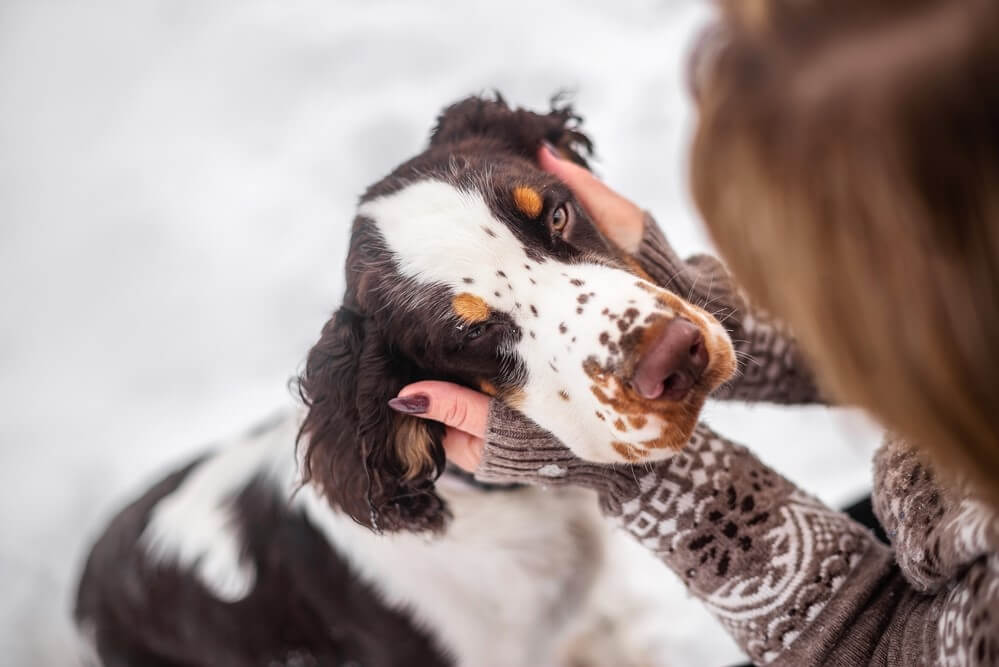Why are My Dog’s Ears Cold?: Your Question Answered

Table of Contents
Are Dog Ears Supposed to be Cold?
No, a dog’s ears cold is not normal. Ideally, your dog’s ears should be at the same temperature as your dog’s body. If a dog’s ears are warm or cold, it could be a sign that something is wrong with them.
However, if your dog’s ears are cold and you also see some signs of swelling, discoloration, trauma, or other issues, it is best to talk to your vet and have them checked out. This is more crucial if you have a puppy or a senior dog.
Additionally, if your dog is on certain medications or is recovering from surgery, it might have cold ears. In extreme weather, it is best to keep your pet warm with the help of a protective layer, irrespective of the dog breed.

What Do Cold Ears Mean on a Dog?
There are several reasons why your dog might have cold ears:
- Age, Breed, and Size. When it comes to cold ears, senior dogs, puppies, small dogs, underweight dogs, and dogs with short fur tend to get cold easier. Therefore the age, breed, and size of the dog can determine how cold your dog’s ears will get.
- Circulation Issues. In case your dog has problems with its circulatory system, chances are that it might develop cold ears. Blood flow through the blood vessels in the ears keeps them warm. Therefore, poor circulation could be one of the reasons why your pup’s ears are cold to the touch.
- Frostbite. If your dog has been exposed to cold weather and cold temperatures, there can be tissue damage. If your dog’s ears are cold in addition to other symptoms such as swelling, blue or gray skin, or blisters, you should talk to your vet asap. These are all signs of frostbite that could turn problematic in no time. If the condition is not taken care of, your dog’s skin might become black.
- Hypothermia. Hypothermia or low body temperature can be a problem if your dog spends too much time in the cold. It is also prevalent in small dogs that just had surgery. If your pup is shivering and has cold ears, you should use a digital thermometer to check their temperature. In such cases, it is important to seek veterinary care at the earliest. Prolonged hypothermia can be life-threatening and impact your dog’s quality of life.
- Hypovolemic Shock. If your dog has had an injury, it can go through hypovolemic shock. This happens due to low blood volume, which can lead to hemorrhage, dehydration, or an issue related to fluid distribution. Additionally, loss of blood could be because of an external wound or internal bleeding.
What Should I do When My Dog’s Ears are Cold?
If your dog has cold ears, it could be indicative of various pathologies and medical conditions. If your dog’s temperature drops, it could lead to a loss of blood pressure and heart rate. Furthermore, it can also lead to arrhythmias, poor circulation, and even cardiac arrest. As the metabolism slows down, it can lead to multi-organ dysfunction syndrome (MODS).
If your dog’s ears are cold because of a drop in body temperature, some of the steps that pet owners can take include:
- Use lamps, electrical appliances, or external heating sources to create a warm environment for your dog.
- Do not increase the body temperature rapidly, as it could lead to shock.
- If your dog becomes wet, make sure that you dry them properly.
- Use blankets and coats to warm your dog. If your dog is a small breed or young in age, use body heat to increase its temperature.
- If your dog is cold, take them out during the warmest time of the day. Also, make sure that the dog is not sleeping outside.
- You can consult a vet who might administer fluid therapies or warm enemas.
- Additionally, your vet might prescribe glucose to prevent or reverse hypoglycemia.
To avoid the progress of the condition, it is best to consult a vet during the starting stages. If your dog’s ears are cold, take a temperature reading, as your dog’s body temperature could indicate a wide range of problems if it is low. This is more common in cold weather and older dogs, which dog owners should be aware of.
When Should I Go to the Vet for Cold Dog Ears?

While the causes of cold ears can be many, it can impact your dog’s vital organs leading to them shutting down in rare cases. If you notice any of the following symptoms besides your dog’s cold ears, it is best to talk to a vet as it could be a sign of anemia in dogs, dog tumors, heart disease, and circulatory problems.
- Shivering. While long-haired dogs are better off in the cold, some short hair dogs need an ambient temperature to sustain themselves. If you see your dog shivering in addition to having cold ears, it is best to take them to a vet.
- Head–Shaking. This can be an indication of circulatory issues in your dog’s body. If your dog has a runny nose and has been shaking its head, it is time to go to a vet.
- Bleeding Ears. In low temperatures, bleeding ears in dogs can be an indication of an underlying problem. It is best to take them to a vet in such a case.
- Whining, Whimpering, or Barking. If your dog is making weird noises that indicate pain, it could be because of extreme temperatures. Take them to a vet to avoid problems getting worse.
- Hunching over or Tail Tucking. This is your dog being submissive and is not usually a sign of a healthy dog. In addition to cold ears, your dog’s nose might also be indicative of an underlying problem.
- Appearing Uncomfortable. If your dog is generally uncomfortable and more irritable, shying away from cuddles could indicate problems. This is more or less observed in dogs like Poodles, Terriers, German Shepherds, and Chihuahuas. Make sure your dog’s health, is in the right condition, as they might require a warm-up.
- Seeking Shelter. In addition to general health problems, if your dog is seeking shelter and curling up in corners, it could indicate problems.
- Teeth Chattering. This is a common sign of your dog being cold. Additionally, you might also notice sneezing and shaking of various parts of the body. A warm compress can help your dog in this case.
- Weakness. Some common causes of cold ears could also be heart conditions leading to your dog becoming extremely weak and anemic.


















